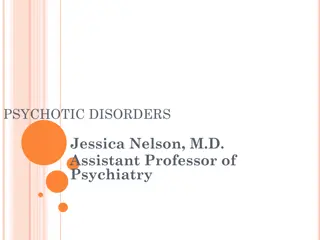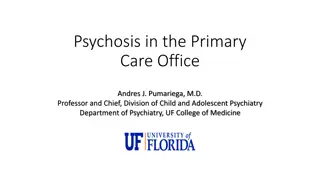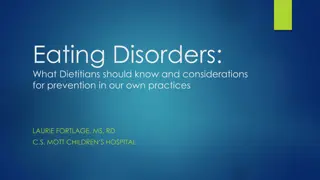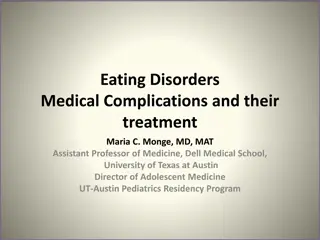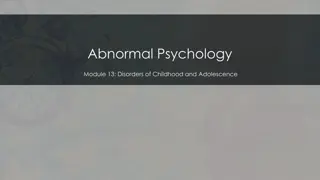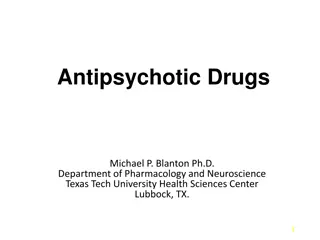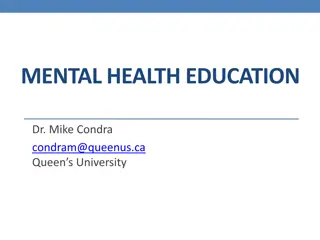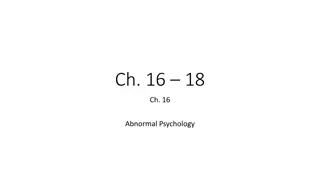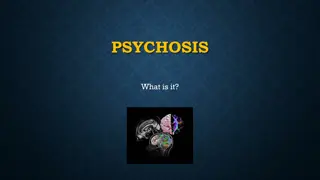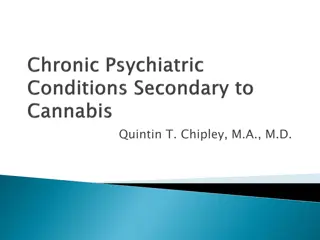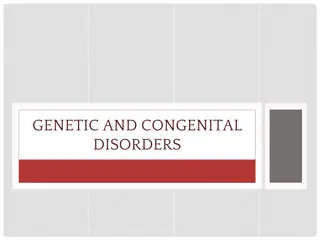Understanding Psychotic Disorders and Their Impact on Global Health
Psychotic disorders are significant contributors to global health burden, affecting mental, neurological, and substance use areas. This content delves into the characteristics of psychotic disorders, their symptoms, diagnostic criteria, and implications for individuals' functioning. It sheds light on the prevalence of psychotic disorders, their varied presentations, and the importance of early screening, diagnosis, and management at primary healthcare levels to improve outcomes and reduce stigma.
Download Presentation

Please find below an Image/Link to download the presentation.
The content on the website is provided AS IS for your information and personal use only. It may not be sold, licensed, or shared on other websites without obtaining consent from the author. Download presentation by click this link. If you encounter any issues during the download, it is possible that the publisher has removed the file from their server.
E N D
Presentation Transcript
MHGap Training: PSYCHOTIC DISORDERS Dr Bokang Letlotlo Psychiatrist Jhb Health District
Mental, neurological, and substance use disorders are major contributors (14%) to global health disease burden (morbidity and mortality) WHO Also the highest stimatised illnesses/disorders Leading causes of disability globally -> significant socio-economic impact Background Low to middle-income countries Gap Action Program (GAP) developed by WHO MHGap
Objectives for general practitioners Screen and diagnose psychotic disorders Management at primary healthcare level Know when to refer for specialized care
Stress And Health Survey (SASH) study Anxiety disorders - 8% South Africa: 16-% prevalence of mental disorders/illnesses Substance use disorders 6% Depressive disorders 5% Others: psychotic disorders <1%, etc..
Psychosis is characterised by a loss of contact with reality Psychotic disorders may present with: Delusions: Fixed beliefs, manifest as disturbed speech content with e.g. persecutory, referential, grandiose, religiose, erotic, bizarre themes Hallucinations: Perceptual disturbances, e.g. auditory Disorganised thinking: Manifests as disordered flow of speech which impairs communication Disorganised or abnormal motor behavior Negative symptoms: reduced emotional expression, avolition, anhedonia, lack of social interaction Other mental disorders, (e.g. bipolar mania, major depression), medical conditions (e.g. certain types of epilepsy), or substance use (intoxication or withdrawal) Psychosis/psychotic disorders
criterion: 2 of delusions, hallucinations, disorganized speech or bx., negative symptoms Level of functioning impaired (cognitive, psychosocial) Disturbance not due to another medical condition or use of substance(s) Disturbance not attributable to another mental illness/disorder (autism, major depressive disorder, etc.) Diagnostic and Statistical Manual of Mental Disorders 5 (DSM-5)
Delusional disorder 1 delusion, 1 month Notable psychosocial stressors Brief psychotic disorder >1 day, 1 month Full return to pre-morbid functioning Marked stressor or postpartum onset Psychotic disorders Schizophreniform disorder >1 month, 6 months 1/3 go into full remission 2/3 may develop schizophrenia or schizoaffective disorder
Schizophrenia Symptoms present for 6 months Schizoaffective disorder Schizophrenia criterion plus mood disorder criterion met Substance-induced psychotic disorder Sx. Occur during or soon after intoxication or withdrawal The substance is capable of producing symptoms Psychotic disorders Medication-induced psychotic disorder Sx. Occur during or soon after medicine intake The drug is capable of producing symptoms Psychotic disorder due to another med. Condition (AMC)
Psychosis is often accompanied by a lack of insight into the symptoms and poor judgement. ? Voluntary vs. Assisted vs. Involuntary User under the MHCA (17 of 2002) Treat severe aggression and disturbed behaviour as in Section 15.1 When to admit
TYPICAL A/P Haloperidol, orally Chlorpromazine, orally LAI s = zuclopenthixol (clopixol) or flupenthixol (fluanxol) decanoate, intramuscularly (IMI) Caution: zuclopenthixol acetate (clopixol acuphase) Antipsychotics ATYPICAL A/P Risperidone Olanzapine Quetiapine (dopaquel or Seroquel) Clozapine
Haloperidol, oral Initialdose:0.5 1mg nocte, Increasing to 5mg nocte If good response/ tolerability to haloperidol, or patients preference: Depot antipsychotic, e.g: Flupentixol decanoate, IM, 10 40 mg every 4 weeks. OR Zuclopenthixol decanoate, IM, 200 400 mg every 4 Neuroleptic choice If poor response/ poorly tolerated/ high risk of tardive dyskinesia/ extra-pyramidal side effects: Risperidone, oral Initialdose:2 4mg nocte Max. 6mg. Assess efficacy after 4 6weeks
If a partial response is noted, optimise the dosage. If no response is noted, switch treatment: Chlorpromazine, oral, 75 300 mg nocte (divided doses) If poor response/ tolerability: Olanzapine, 5-20 mg nocte Clozapine, oral (specialist initiated, preferably as inpatient) Neuroleptic choice Initialdose:12.5 25mg at night Usual dose: 200 450 mg per day in divided doses Maximum dose: 900 mg/day in divided doses.
Neutropenia (3% of cases) and agranulocytosis (0.8% of cases) Baseline: normal wcc and absolute neutrophil count Monitor wcc and neutrophil count weekly X 18 weeks -> monthly - Withdraw clozapine if neutrophils <1.0 x109/L Myocarditis: highest risk in first two months of treatment. Monitor pulse, blood pressure, temperature Clozapine side- effects Seizures: risk increased at doses >450 mg/day Manage as for epilepsy, section 14.4: Epilepsy, Lamotrigine preferable as it is weight neutral and does not interfere with clozapine metabolism Constipation: avoid anticholinergics. Give a prophylactic laxative Metabolic syndrome risk fx
Typical A/P EPSE s Dystonia Dyskinesias Parkinsonism Atypical A/P Metabolic syndrome risk/vascular risk fx. Blood pressure changes Hyperglycaemia/glucose intolerance Increased body mass index (BMI) Dyslipidemia (esp. TG) Manage as per PHC STGs and EML, section 16.6: Psychiatric patients general monitoring and care; Prevention of ischaemic heart disease and atherosclerosis (section 3.1), and Type 2 diabetes mellitus (section 8.5.1) Side effect profile Arrythmias
Dyskinesias Avoid anticholinergics! Parkinsonism and dystonia Anticholinergics, e.g. Orphenadrine, oral, 50 150 mg daily according to individual response Usual dose, 50mg 8 hourly Maximum dose,150mg daily Use with caution in the elderly as it may cause confusion and urinary retention Benzodiazepines may help consider treatment review/psychiatrist referral Extra-pyramidal side-effects (EPSEs)
when not surecall a colleague! THANK YOU..




